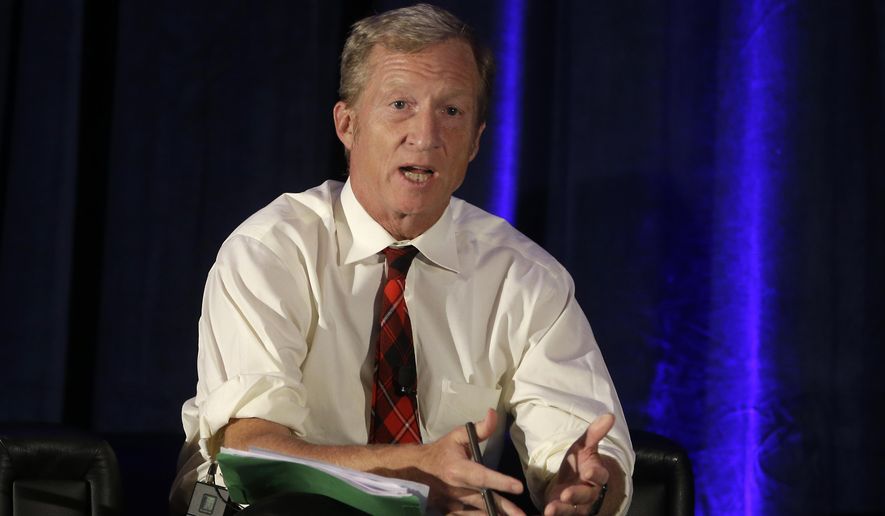DENVER — In terms of bang for the buck, there was no bigger loser in the November elections than liberal billionaire Tom Steyer, who beat his own individual federal spending record but failed to break .500 when it came to backing candidates.
The San Francisco hedge fund manager sank $87.6 million into Democratic candidates and causes, making him the leading individual funder of the 2016 election cycle and easily surpassing the $75.4 million he spent on federal races in 2014, when he was also the top donor, according to OpenSecrets.
That largesse failed to buy him a winning record. Of the seven federal candidates — Democrat Hillary Clinton and six Democratic Senate hopefuls — supported by his NextGen Climate Action Committee, only three won their races.
Mr. Steyer also backed the victor of the tight North Carolina governor’s race, bringing his tally to 4-for-8.
The mediocre outcome represented a slight improvement from the 2014 midterm elections, when Democratic candidates for Senate and governor backed by Mr. Steyer went 3-for-7.
Even so, Mr. Steyer, who jumped into politics three years ago to push climate change as a campaign issue, said after the Nov. 8 elections that he wouldn’t change a thing.
“Did we get the president we want? Absolutely not. Did we get a majority of clean energy supporters in the Senate? No,” Mr. Steyer told the Reuters news agency. “But in terms of what we did, and the strategy we took, we wouldn’t do anything differently.”
Meanwhile, his spending has become fodder for critics of his climate change agenda, who have suggested that Mr. Steyer may want to stick to investing in stocks instead of campaigns.
“Tom Steyer isn’t just bad at politics; he’s the biggest loser of the past two election cycles,” said Simon Lomax, an associate energy policy analyst at the free market Independence Institute in Denver.
“He has spent at least $163 million trying to keep Republicans from running Congress and the White House, and failed miserably on both counts,” said Mr. Lomax, an oil and gas industry consultant. “He spent that money lecturing voters about climate change and dismissing their very real economic concerns about the cost of fringe environmental proposals that would dramatically increase energy prices.”
Mr. Steyer’s emphasis on climate change failed to sway the electorate, he said, and may have alienated voters in key Rust Belt states worried about the Obama administration’s “war on coal” and its impact on jobs and economic growth.
A Fox News exit poll found support for the Democratic presidential candidates among union voters dropped by 10 percentage points from 2012 to 2016, marking the lowest union support for a Democrat in 20 years.
“His obsession with climate politics and his support for the ’keep it in the ground’ agenda drove blue-collar voters away from the very candidates he was trying to help,” Mr. Lomax said.
When deciding upon candidates, NextGen doesn’t just choose Democrats; it chooses Democrats willing to fight fossil fuels in the name of combating global warming. NextGen declined to endorse the re-election bid of Sen. Michael Bennet, a Colorado Democrat who supported the Keystone XL pipeline.
NextGen also notched less-than-stellar returns on its strategy of increasing voter turnout among millennial voters by engaging them on climate change.
“The millennial vote may be decisive — and millennials are voting for Clinton because of climate change,” NextGen strategic adviser Jamison Foser declared in a Nov. 4 memo.
But postelection figures show 18- to 29-year-old turnout barely budged, ticking up from 49 percent in 2012 to 50 percent and falling short of 2008, when it reached 52 percent, according to the Center for Information & Research on Civic Learning & Engagement at Tufts University.
Mr. Steyer said voter turnout among young people was up 20 percent in areas where NextGen focused its efforts. Still, it wasn’t enough to hold back a wave for Republicans, who captured the presidency and retained control of the House and Senate.
The three Senate Democrats endorsed by NextGen who won their races were Rep. Tammy Duckworth, who upended Sen. Mark Kirk in Illinois; New Hampshire Gov. Maggie Hassan, who ousted Sen. Kelly Ayotte; and Nevada Attorney General Catherine Cortez Masto, who defeated Rep. Joe Heck.
Steyer-backed Democrats who lost were Katie McGinty, who fell to Sen. Patrick J. Toomey in Pennsylvania; Deborah Ross, who was defeated by Sen. Richard Burr in North Carolina; and former Ohio Gov. Ted Strickland, who was defeated by Sen. Rob Portman.
NextGen Climate also endorsed North Carolina Attorney General Roy Cooper, who edged Republican Gov. Pat McCrory.
The rankings by OpenSecrets, a project of the Center for Responsive Politics, show that Democratic donors overall failed to realize returns on their investments in November.
Six of the top 10 federal donors were pro-Democrat, contributing a combined $238 million to candidates and causes, compared with $155 million donated by the top 10 pro-Republican contributors.
Placing second to Mr. Steyer was Las Vegas billionaire Sheldon Adelson, a supporter of Donald Trump who spent $82 million in federal contributions to Republican candidates and causes.
Top Democratic moneyman George Soros placed 12th with $21 million, and former New York Mayor Michael R. Bloomberg came in 11th with $21.1 million to Democratic causes and candidates.
Far behind them was one of the best-known Republican donors, Charles G. Koch, who came in 50th among individual donors with $3.8 million.
The ranking by OpenSecrets, a project of the Center for Responsive Politics, includes individual contributions to federal candidates, parties, PACs, 527 groups, and Carey committees.
• Valerie Richardson can be reached at vrichardson@washingtontimes.com.




Please read our comment policy before commenting.